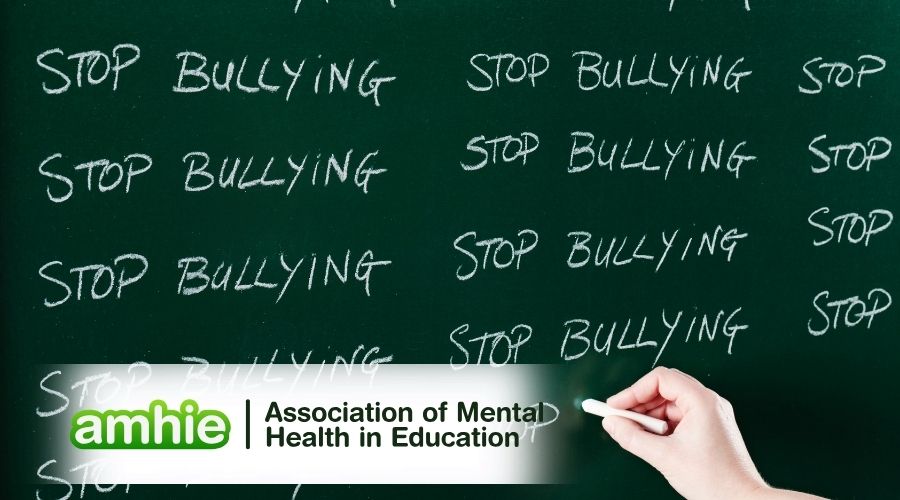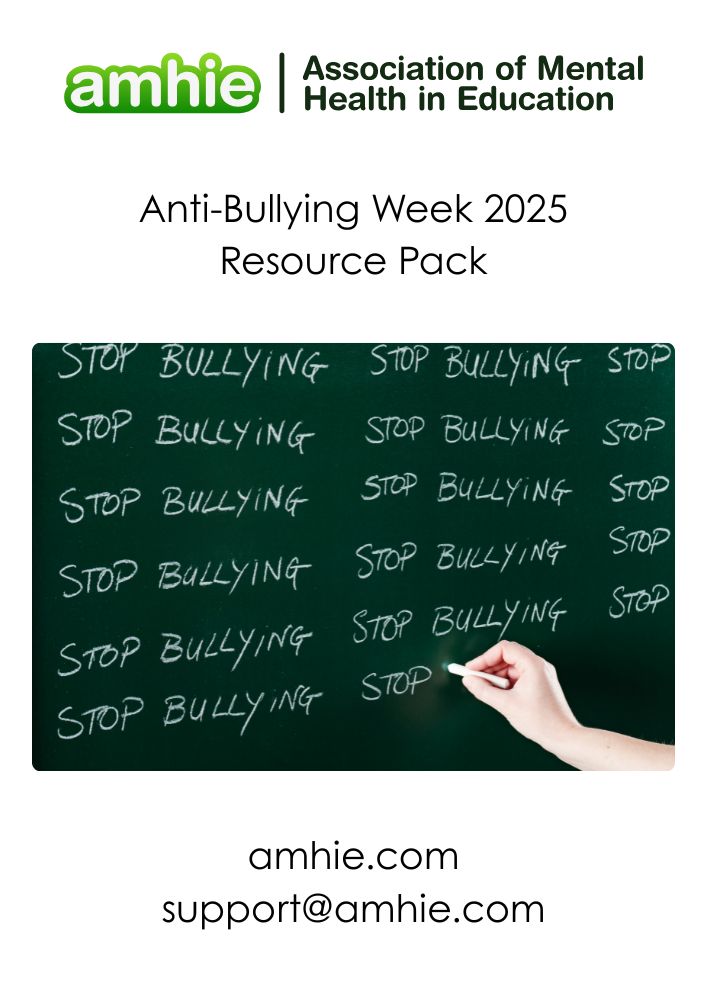
Harnessing the Power for Good: Your Whole-School Blueprint for Anti-Bullying Week and Beyond
Welcome to Anti-Bullying Week. The theme this year, ‘Power for Good,’ is a powerful reminder that every member of the education community—from TA to Headteacher—holds the critical leverage needed to shift a negative school culture.
At the Association of Mental Health in Education (AMHIE), we know that bullying isn’t simply a behaviour problem; it’s a well-being crisis rooted in a complex imbalance of power. To truly honour the theme, we must move beyond quick fixes and commit to a robust, evidence-based approach.
Here, we explore the core causes of bullying and outline the most effective forms of intervention your school can implement for sustainable change.
PLUS! Free members of AMHIE can access their Anti-Bullying Week Free Resource pack – find out more
What Fuels Bullying? Understanding the Power Imbalance
Bullying is defined by aggressive, repeated, and intentional acts carried out against a victim who cannot easily defend themselves. The underlying causes involve a complex interplay of individual psychology, family environment, and the social dynamics within your school.
1. Characteristics of the Perpetrator (The Bully)
Contrary to the common narrative that bullies are deeply insecure, research reveals a more complex profile:
- Need for Dominance: Bullies often exhibit a strong desire for power and control, enjoying the subduing of others.
- Low Empathy: They typically hold a positive attitude towards aggressive behaviour and show little anxiety or empathy for their victims.
- The Family Link: A strong predictor of aggressive behaviour is a home environment characterised by too little warmth and involvement, and frequently, permissive attitudes towards aggression or the use of power-assertive discipline (e.g., physical punishment). In essence: violence begets violence.
2. Vulnerability in the Victim
Victims are targeted due to a perceived lack of ability to defend themselves—the core of the power imbalance.
- Personality & Reaction: Victims are generally more anxious, insecure, and sensitive, often responding to attacks with withdrawal or crying, which signals worthlessness and can reinforce the bully’s behaviour.
- Targeting Difference: Bullying frequently targets perceived differences. This includes students with a Special Educational Need (SEN) or a disability, young carers, those from specific family structures, or those targeted due to homophobic bullying focusing on actual or perceived sexual orientation.
- Lack of Social Support: Victims are often lonely and lack even a single good friend in their class—that essential protective factor.
3. The Peer Group & School Climate
Bullying is fundamentally a social process. The behaviour of bystanders, assistants, or reinforcers can either empower the bully or weaken the aggression. A lack of clear adult supervision or an ambivalent teacher attitude plays a major role in determining if bullying is allowed to flourish.
The Most Effective Intervention: A Whole-School Strategy
Effective anti-bullying efforts cannot rely on isolated activities; they require a comprehensive, multi-level approach—a robust security system for your school community.
The successful, research-based model (such as the one pioneered by Olweus in Scandinavia) is built on an authoritative adult-child interaction model focused on three core levels:
1. School Level: Policy, Awareness, and Supervision
This is your foundation. Every adult in the school must be aligned.
- Better Supervision: Increase adult presence in ‘hotspot’ areas like recess, corridors, and lunch halls.
- Whole-School Policy: Develop clear rules, routines, and procedures for defining, reporting, and dealing with all forms of bullying (including subtle, indirect forms like social exclusion and rumour spreading). Involve students and parents in drafting this policy for ownership.
- Increase Awareness: Utilise questionnaires or surveys to accurately assess the extent of the problem in your setting—teachers often overestimate their own effectiveness.
2. Class Level: Culture and Curriculum
This is where the culture shifts through teaching.
- Establish Class Rules: Clearly define and regularly revisit firm limits against unacceptable behaviour.
- Embed SEL and Empathy: Use regular class meetings and lessons to teach emotional literacy, perspective-taking, and active listening. Equip students to recognise peer distress and understand the impact of their actions.
3. Individual Level: Targeted Support and Follow-Up
Intervention must be consistent, caring, and serious.
- Talks with Involved Students: Hold serious, non-punitive talks with both the bully and the victim. For victims, this may involve assertive training and social skills enrichment.
- Parental Involvement: Education and involvement of parents (both bully and victim) is a highly effective prevention strategy that can lead to a 50% reduction in incidents.
- Peer Support Systems: Establish safe peer support systems (mentoring, befriending) and ensure that victims feel confident in disclosure. Victims who tell a peer, teacher, or family member are far more likely to become ‘escaped’ victims.
Take Action: Get Your Free Resources & Join AMHIE

The ‘Power for Good’ belongs to every professional dedicated to creating a safe and mentally healthy learning environment. Your first step to building a truly effective strategy is accessing expert resources and training.
To support your school’s effort, we have put together a FREE Resource Pack containing three immediate-use resources based on these effective intervention strategies:
- FREE Resource 1: Quick-Start Empathy Builder (5-minute form time activity)
- FREE Resource 2: ‘Power for Good’ Allyship Pledge & Checklist
- FREE Resource 3: Staff Anti-Bullying Week Discussion Template
To receive your free resources and stay informed on our AMHIE Certified Training Programmes—which provide the detailed, sustained expertise needed for whole-school implementation—we invite you to become a free AMHIE Member today.
Harness your Power for Good. Secure your resources now.

#AntiBullyingWeek #PowerForGood #MentalHealthInEducation #SchoolCulture #AMHIE
References:
Bauman, Sheri, and Adrienne Del Río. “Knowledge and beliefs about bullying in schools: Comparing pre-service teachers in the United States and the United Kingdom.” School Psychology International 26.4 (2005): 428-442.
Green, Rosie, Aleks Collingwood, and Andy Ross. Characteristics of bullying victims in schools. London: Department for Education, 2010.
James, Alana. “School bullying.” Res briefing Nedlastet fra www nspcc org uk/inform 26 (2010): 2012.
McEachern, Adriana G., et al. “Bullying in schools: International variations.” Journal of Social Sciences 8.02 (2005): 51-58.
Menesini, Ersilia, and Christina Salmivalli. “Bullying in schools: the state of knowledge and effective interventions.” Psychology, health & medicine 22.sup1 (2017): 240-253.
Muijs, Daniel. “Can schools reduce bullying? The relationship between school characteristics and the prevalence of bullying behaviours.” British journal of educational psychology 87.2 (2017): 255-272.
Olweus, Dan. “Bullying at school: basic facts and effects of a school based intervention program.” Journal of child psychology and psychiatry 35.7 (1994): 1171-1190.
O’Brien, Niamh. “Secondary school teachers’ and pupils’ definitions of bullying in the UK: a systematic review.” Evidence & Policy 5.4 (2009): 399-427.
Rigby, Ken. “Consequences of bullying in schools.” The Canadian journal of psychiatry 48.9 (2003): 583-590.
Rigby, Ken. “Addressing bullying in schools: theory and practice.” Trends & Issues in Crime & Criminal Justice 259 (2003).
Rivers, Ian, and Helen Cowie. “Bullying and homophobia in UK schools: A perspective on factors affecting resilience and recovery.” Journal of Gay & Lesbian Issues in Education 3.4 (2006): 11-43.
Salmon, Gilly, Anthony James, and David M. Smith. “Bullying in schools: self reported anxiety, depression, and self esteem in secondary school children.” BMj 317.7163 (1998): 924-925.
Side, Jeremy, and Kelley Johnson. “Bullying in schools: Why it happens, how it makes young people feel and what we can do about it.” Educational Psychology in Practice 30.3 (2014): 217-231..
Wood, Diana F. “Bullying in medical schools.” Bmj 333.Suppl S4 (2006).
